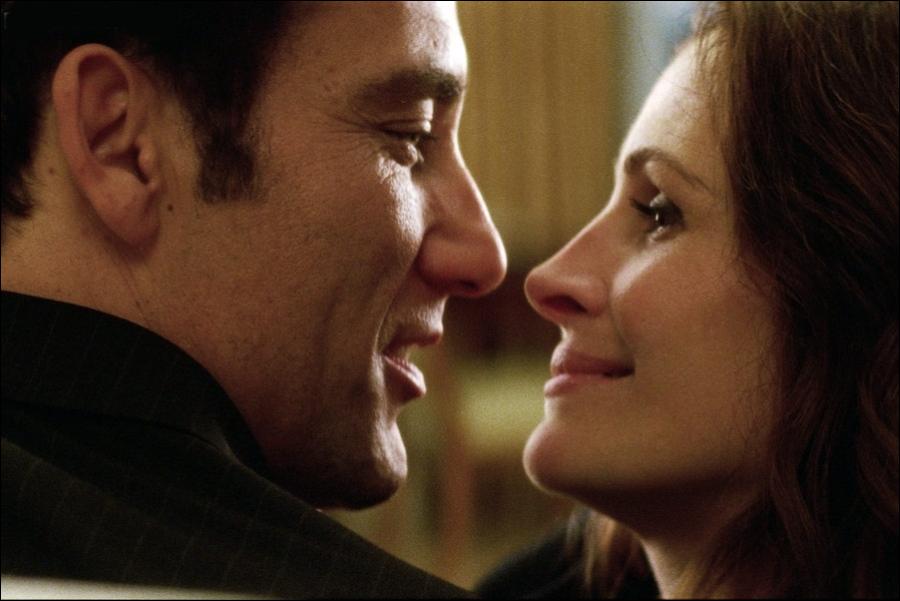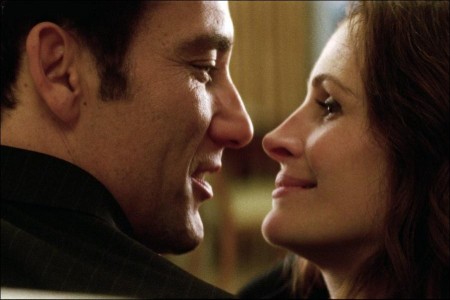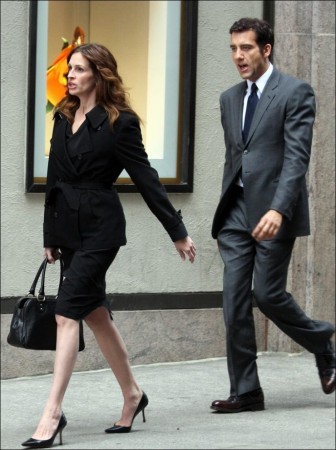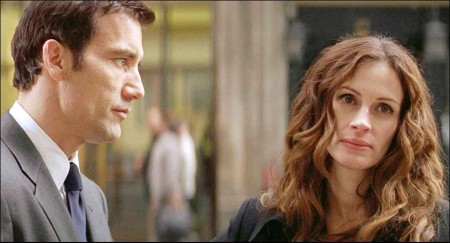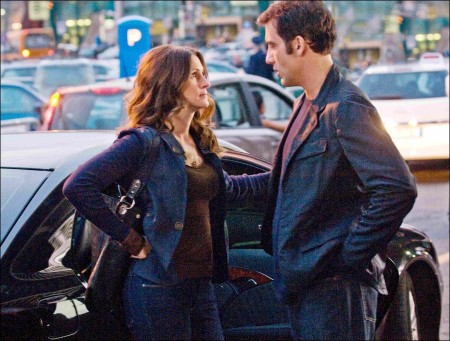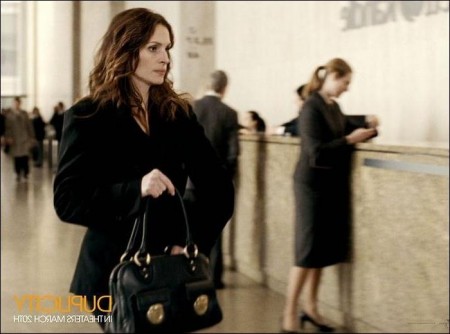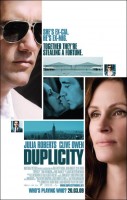Secrets and Lies: Duplicity is Imagined
After he helmed his critically acclaimed 2007 directorial debut, Michael Clayton, writer / director Tony Gilroy decided to return to the arena of corporate dirty tricks…but this time with an eye toward romance. He created a story filled with twists and turns, using the backdrop of a cutthroat race between rival titans vying to be the first to bring a miracle product to market. The heart of the story, however, is the emotional warfare between a pair of romantically challenged, strong-willed lovers who happen to be on either side of the corporate battle… or so it seems.
The idea for Duplicity started with Gilroy’s fascination with the intricacies of industrial espionage. His years of research as the architect of the screenplays in the blockbuster Bourne franchise had introduced him to many people in the intelligence community, and he had noticed that many of them had recently gone into the private sector. Gilroy crafted a nimble script set in this world that combined elements of the screwball comedy with the plot reversals of a classic caper.
Of his research and inspiration for the story’s setting, he shares, “The statistics of corporate theft are somewhere between $50 and $100 billion every year. There isn’t a major corporation on the planet that doesn’t have a competitive intelligence department with some form of either defensive or offensive intelligence gathering, which are basically spy units.”
The filmmaker designed a cold war between two giant corporations in which the spies are actually trying to dupe their employers. He constructed an intricate web of deceit between the rival magnates, and he inserted agents into the mix whose love is as high stakes as the scheme itself.
This star-crossed pair is ex-CIA agent Claire Stenwick and former MI6 operative Ray Koval. Gilroy underscores that their personal entanglements are complicating their jobs, and the constant deceit makes it hard to know where they stand with one another. He says, “They never tell the truth. Everybody’s gaming everybody; everything is constantly not what it seems.”
We meet Claire and Ray through a series of flashbacks that track their relationship-beginning with their first encounter in Dubai in 2003 and taking us through the plotting of their big heist in Manhattan of today. When he imagined the couple, one curious question kept coming to the filmmaker’s mind: “How do scorpions make love?” Of the idea, Gilroy elaborates: “I wondered what happens if two people fall in love who are both professional liars. It’s really hard for them; who else is there for them? They’re their own species.”
The first time they meet, then-MI6 operative Ray is simply a mark for CIA agent Claire. She seduces him at a consulate party in Dubai, drugs him and then ransacks his room to steal Egyptian Air Defense codes. Elaborates Gilroy’s production partner, producer Jennifer Fox, of the setup: “Claire leaves Ray with this smile on his face. He’s both completely taken with this woman and incredibly frustrated. He needs to find her. They meet again in Rome, have a lost weekend and decide to work together and leave their jobs with the CIA and MI6 and go private…to cash in and have one big giant score that will allow them to be together.”
Gilroy adds, “After Dubai, they don’t see each other for a long time, and they reconnect under very unusual circumstances. The whole movie is about the two of them deciding whether they’re really in love, whether they can trust each other and whether they’re going to get rich in the middle of this corporate espionage war.”
Gilroy also created Howard Tully (head of Burkett & Randle) and Dick Garsik (head of Omnikrom), two giants among pharmaceutical world whose ambition and hatred for one another is matched only by their egos. He says, “This feud between Tully and Garsik is the engine for everything that happens in the story. It’s a cold war set on Park Avenue between two huge, giant corporations instead of two countries…but fought just as bitterly and with just as much complexity.”
For Duplicity to be plausible, Gilroy knew the stakes for the characters had to be as high as they would be in an actual cold war. That meant imagining a race to patent a drug so hotly in demand that it would tip the market for any patent holder and render competitors impotent. The filmmaker elaborates: “We needed something everybody was chasing, in which the stakes were really high-the holy grail of everything financially.”
Producer Fox agreed with his instincts. “One of Tony’s great strengths is creating characters who are strong, dynamic and smart,” she notes. “I think he’s done that here with Claire and Ray. Audiences will have fun with the film and enjoy puzzling out the story. In the same way that the characters are conning one another, Tony is playing a con game with us, and the surprises don’t let up until the last moment.”
Tortoises and Hares: Casting the Caper
When he created his main characters for Duplicity, Gilroy imagined the two lovers as unable to be honest about anything, especially their feelings. He needed to find performers who were believable as spy rivals and romantically complicated. Julia Roberts and Clive Owen were the perfect pairing. Roberts was asked to come onto the project and play Claire Stenwick, Burkett & Randle’s assistant director of counterintelligence (secretly reporting to Omnikrom). Owen was brought on as Ray Koval, an ex-MI6 agent who now serves as Claire’s contact officer at Omnikrom.
About their on-screen pairing, Fox notes, “Duplicity is reminiscent of a certain kind of glamour from films of the past, and so it was terrific to have such glamorous movie stars at the center. Julia and Clive have the kind of chemistry that no costume design, production design or location can provide.”
Though he’s written for and directed a who’s who of Hollywood talent, Gilroy admits casting Academy Award winner Roberts as his leading lady made him a bit nervous. “You get past your first, `Oh, this is Julia Roberts and I’m working with her,’” he laughs “You watch her working, and it’s effortless. She’s such a veteran and so smart about what the camera means to her.”
Roberts has spent the past several years raising young children and starring in successful ensemble pieces. Duplicity marks her much-anticipated return as lead in a film. The actor was fascinated by Claire and the fact that she was so romantically lost while so laser focused on her mission in work. Too, she looked forward to once again working with her Closer co-star, Clive Owen, for the caper.
She explains her motivation for agreeing to the part: “Clive had first asked me to be in this movie, and then Tony had written me a letter when he sent me the script. I was really flattered to be asked to play Claire, because she’s not altogether likeable or trustworthy. But when all is said and done, she wears her heart on her sleeve in a way that was quite interesting to me. I thought it was great to play somebody who is a little more convoluted than your normal on-screen woman.”
Roberts’ part in Duplicity marked an interesting deviation from other roles in her body of work. In Gilroy’s script, Claire and Ray have brief romantic interludes in multiple cities across multiple time zones. For Roberts, playing a jet-setting superspy was an intense experience as the crew crafted scenes set in various locales from Rome and Dubai to Cleveland and Zurich. Indeed, she felt as if she and Owen were acting in, “little bubbles… little capsules that we performed within.” Fortunately, her longtime friend was along for the wild ride.
“Clive is the ultimate leading man,” she compliments. “He’s great in this part, and I love when he plays like he’s at a loss. His earnest qualities are so truthful, and I loved acting with him…every minute of it. He comes in really prepared and is able to enjoy the process. We have that same goal: to do a great job and to have such a good time.”
From this season’s The International to such thrillers as Inside Man and The Bourne Identity, some of Clive Owen’s most notable roles have delved into suspense and theft. He came to Duplicity through the friendship of another one of Julia Roberts’ leading men, George Clooney. Clooney introduced Owen to his Michael Clayton director and recommended him for the role of Ray Koval. “I’d written for Clive in the first Bourne movie, but I hadn’t met him,” says Gilroy. “I’d been watching his work and thought he was just amazing. When George introduced us, I went right away for him for the film.”
After reading the screenplay, the man whom Fox describes as full of “Cary Grant charm and charisma” was eager to work on the project. “I finished the last page of the script and grabbed the phone and called my agent and said, `This is the one. This is the script,’” remembers Owen. “I had a very huge, strong, instinctive response. I thought the writing was brilliant and was very keen to get involved.”
Working with Roberts again was a carrot for Owen, as was being directed by the man who envisioned the source material. “One of the huge attractions for me to do this film was to get the opportunity to say this kind of dialogue with Julia. It’s so well written that, in some ways, you don’t have to make that many decisions as an actor. You have to sit in it like a very comfortable car and just drive it, because the rhythms are all there. It’s a joy when you’ve got that kind of language to play with, and to play it with someone like Julia, who is fantastic with this type of material.
On partnering with Gilroy, Owen commends: “He writes brilliant dialogue. It trips along, and it’s got great rhythm. It feels natural. Within three pages of reading this script, I was excited by the dialogue and couldn’t wait to go to work. It’s all there in front of you, and it’s very clear what’s required. The advantage of a writer/director is that he’s on set and can explain his initial impulses when he wrote the script. That’s a very nice thing for an actor.
“At the end of the day, it’s funny, it’s witty, it’s very buoyant and it’s unusual,” he continues. “It’s a guy and woman who are in love, but they argue a lot and they mistrust each other-as well as being crazy about each other-and that lends to a really entertaining experience for the audience.”
Duplicity opens with Claire’s and Ray’s employers racing toward one another on a rain-soaked airplane tarmac-preparing to beat the hell out of each other. To play Howard Tully, the Zen (yet vindictive) head of industrial giant Burkett & Randle, the production cast Tom Wilkinson. The veteran British performer, whose work with Gilroy on Michael Clayton earned him an Oscar nomination, was matched with Paul Giamatti, who was brought aboard to play Omnikrom’s übervengeful CEO Dick Garsik.
The two, fresh off Golden Globe wins for the celebrated HBO miniseries event, brought to life what Fox calls “the tortoise and the hare” methods of ruling their empires.
Says Gilroy of Wilkinson: “Tom just makes life so easy. We told him about the opening fight scene, in which he would have to participate in a choreographed fight with Paul, and he was happy to do it. From the moment that he says, `Yes,’ if you’re the director and writer, you can immediately relax.”
To prepare for his role, Giamatti was asked by his director to watch Stanley Kubrick’s 1964 masterpiece, the nihilistic comedy Dr. Strangelove. Gilroy felt Giamatti could inform his character by seeing how George C. Scott played the unflappable General “Buck” Turgidson. Says Gilroy, “The reference I gave Paul was that he has to be a winner in this thing all the way through. I wanted his character to have that same confidence that George C. Scott had.”
When it came time to play the megalomaniac Dick Garsik, Giamatti erased all the compassion he had fostered for and delivered in his portrayal of John Adams. He describes his experience on set: “Playing a corporate guy is like playing a king in a Shakespearean play: you’re master of everything. I have to switch into the mind-set of not caring about anybody around me and believe they’re just going to do whatever I tell them to do.”
Of his experience with the filmmakers, he notes: “Tony’s got a great visual sense, and he works very well with Robert Elswit, the cinematographer. He’s prepared and thinking way ahead, which is all things that you would think any director would do, but they don’t necessarily. You feel completely safe that this guy knows what he wants, and you still have a lot of freedom to play around in it.”
Rounding out the cast stationed alongside Julia Roberts and Tom Wilkinson at Burkett & Randle’s counterintelligence bureau are Michael Clayton’s Tom McCarthy as Claire’s fellow agent Jeff Bauer, a man Gilroy writes is “torn between the desire to seduce and destroy,” and Claire and Jeff’s supervisor, Pride and Glory’s Wayne Duvall as former marine / cop / FBI agent Ned Guston. True Blood’s Carrie Preston rejoins her My Best Friend’s Wedding co-star to play the firm’s naïve travel department executive Barbara Bofferd, while Charlie Wilson’s War’s Christopher Denham appears as strung-out genius/inventor Ronny Partiz, who can easily be found blowing hundreds of thousands each week at a baccarat table in the Bahamas.
Assisting Clive Owen and Paul Giamatti at Omnikrom’s secret guerilla espionage facility are Milk’s Dennis O’Hare as ace project leader Duke Monahan; The Good Shepherd’s Oleg Stefan as the firm’s thuggish Boris Fetyov; Battlestar Galactica’s Rick Worthy as Omnikrom muscle Dale Raimes; Kinsey’s Kathleen Chalfant as brilliant Jane-of-all-trades Pam Frales; Khan Baykal as computer genius Dinesh Patel; and Dan Daily as Garsik’s long-suffering aide.
Global Shoot: Rehearsal, Design and Locations
Rehearsal
So his co-stars would be able to nail the tempo of their rat-a-tat dialogue prior to shooting, Gilroy spent a week rehearsing scenes with Roberts and Owen. “You’re prospecting all the time and desperate for things to happen that are not planned,” he says. “It’s happened here. The chemistry between Clive and Julia is really strong, and it’s smart.”
Roberts welcomed the extra week to prepare for the film and slip into, as Gilroy phrases, “the wardrobe of her character.” She also appreciated the luxury of time to rehearse for a role, versus jumping right into it. Both Roberts and Owen respected that Claire and Ray have prepared for this heist for years and were determined to have every look, nuance and minute detail in place. They will do anything not to risk losing $40 million. Indeed, it would take every minute of rehearsal time for the actors to prepare to deliver Gilroy’s lines just as rapid-fire as they were written.
To put him in the mind-set of the control freak Garsik, Giamatti was sent to an Upper East Side men’s barbershop for a taste of the pampered life one would expect a mogul to enjoy. Explains Jennifer Fox: “Paul is so down-to-earth, not the guy who would be doing this on his own. We wanted him to get the manicure and have a shave in one of those old-fashioned men’s clubs-to have that pristine, corporate feeling.”
The opening sequence of the film has our two CEOs racing toward one another. Wilkinson was game to rehearse the fight in a dance studio with Giamatti. To set the stage, Tully and Garsik have disembarked from their private jets, have left their entourages behind and launch into a playground brawl. To prepare for this scene-ultimately shot in an airline hangar in Upstate New York-the two men grappled around comically on wrestling mats. Recalls Fox, “We planned every move with a stunt coordinator, and we used padding on the ground. There’s this moment when Tom picks up Paul, and he’s in the air, then lands on the ground. Their fists are flying; it’s out of control and fantastic.”
Design
It was important to Gilroy for the competing companies to have a distinct look and feel. Burkett & Randle was designed to present an identity that was very clean and stark, because its counterintelligence agency was underground, dark and buzzing with activity and high-tech spy systems; it was built to feel like a clinical bunker. In contrast, the Omnikrom unit was more a collage of texture, pattern, layers and transparencies.
Says production designer Kevin Thompson of the steps he took with the filmmakers: “You start with very basic, rudimentary ideas, like Burkett & Randle is going to be white and minimal, and their theme color is going to be blue. The Omnikrom team is going to be the red team, and they are going to be much more high-tech with layers of texture and grays and no white or blue at all. Oddly enough, Burkett & Randle’s logo ended up being blue, and Omnikrom’s logo was red.”
Thompson has a high regard for Gilroy’s aesthetics.“Tony’s extremely visual and very specific in what he likes: clean lines, restful compositions and fairly masculine designs,” he says. “Because he’s a writer, he can articulate what he likes visually; it’s a real asset to the designer.”
Shooting on Location
Burkett & Randle and Omnikrom are both headquartered in Gilroy’s hometown of New York City, while the film’s flashbacks take us into Claire and Ray’s secret rendezvous cities-from, chronologically, Dubai, Rome and London to Miami, Cleveland and Zurich. Principal photography for Duplicity began in Manhattan, then the company moved to the Atlantis Resort in the Bahamas for one week of shooting. It spent the final week of production in Rome, where Claire and Ray first fell in love and began, as Gilroy puts it, “stealing little moments.” Thompson had the enviable job of creating sets in some of the most famous buildings and locations in the world.
About the decision to shoot in Manhattan, Thompson offers, “It was always important to have real New York streets and classic New York locations, but not shoot them in a traditional Hollywood way.” One of the earliest scenes in the film shot in Grand Central Station, which was filmed at the pedestrian level for a greater sense of urgency. Several iconic New York buildings were used for interior and exterior shots of the rival company’s offices. For example, the roofs of the MetLife Building and Rockefeller Center were used to capture establishing shots of the Big Apple. DP Elswit and his team were especially pleased to be among the first filmmakers to lens the city with the new Panavision G-Series lenses.
“Grand Central was important, as was the big shopping scene in Lord & Taylor where Clive finally catches up with Julia,” Thompson says. “Being on Fifth Avenue in midtown, Central Park, the Chase Manhattan Bank Building, the top floor of the Citicorp Building, Lever House, the Seagram Building…these are the most beautiful, classic pieces of architecture we have in the city, and we shot in them.”
One of the more challenging locations to secure was space in the Seagram Building. The production intended it to serve as the power center for the head of Burkett & Randle. Producer Kerry Orent explains: “The Seagram’s location allowed Tony to position Howard Tully’s office at the center of the Midtown Manhattan canyon of corporate and financial power. The location gave Tony the opportunity to present Tully’s office within a certain distance to his archrival’s Omnikrom building. At the time of filming, it was very difficult to find empty office space in midtown, especially in famous architectural icons like Seagram’s. After months of searching, Kevin Thompson found a rare, empty space in that building. With Tony’s support, Kevin transformed an unfinished space that had wires hanging down and Sheetrock falling over into a perfectly designed office for Tully.”
Filming Ray’s pursuit of Claire through Grand Central Station made the Seagram Building prep look like a walk through Central Park. Shares Orent of the experience of coordinating with everyone from the Metro North Transit Authority to NYPD: “At Grand Central, we had less than five hours to shoot a complicated scene with hundreds of extras…before thousands of Grand Central commuters started arriving. We were required to start at 4 a.m. on a Sunday morning. It was the only window of time that Metro North could allow us to have some control of the vast space. By 9 a.m., we hurried to complete the sequence. We couldn’t stop the trains from coming or tell travelers that they couldn’t pass through the station.
“It was a lot of planning for weeks in advance,” Orent continues, “but with a lot of cooperation and Tony’s willingness to work with our limitations, he designed an amazing shot that starts on the clock in Grand Central Station and comes down to reveal Clive discovering Julia.”
Additionally, New York served as a wealth of unexpected locations for our jet-setting spies. The interior of the hotels in London, Rome and Dubai were shot in the city, with establishing shots of those locales accomplished by second units.
The crew moved on to the Atlantis Paradise Island Resort in the Bahamas, where it filmed three of the script’s locations in one spot. In addition to the Atlantis scenes in which our spies seek answers from a very drunk Ronny Partiz at the baccarat table, the resort’s Ocean Club doubled for other script locales. This includes the Miami bungalow scene in which Ray and Claire agree she’ll work for Omnikrom (at the counterintelligence desk for Burkett & Randle)…as well as the pool scene at the American Consulate in Dubai (where our lovers first meet). Fortunately for the writer/director, the casino in which he ended up shooting was the exact location he’d written about.
Rome was the final stop in the production shoot. In this city, Claire and Ray reconnect-in a flashback sequence-three years after they first met in Dubai. The advance team spent months looking for ideal spots in which to lens, according to Orent. He recalls: “The locations that Tony selected in Rome were based on a long process of scouting and working with the Italian government to get the proper approvals to film in the old part of the city. One of our principal locations for filming was the plaza adjacent to the Pantheon. It is the perfect setting for the sequence where Clive discovers Julia walking across the plaza. It took a long time to secure this location. We were not sure that we would get a permit to film in the plaza because it is such a big tourist attraction.Our Italian production team spent months working with the government authorities to get approval to shoot there.”
Gilroy felt these exteriors needed to represent the classic, romantic places he fell in love with during his visits to the region. Designer Thompson elaborates: “We scouted at the Piazza Navona and the Pantheon, and we went into the Jewish ghetto. We wanted a romantic setting that started big and then goes through the alleyways and into a more intimate piazza, the Piazza Margana-the classic old section of the town. Tony loves it and fantasized about making a movie there, so it was where Clive and Julia had to have their scene.”
Though the crew shot extensively in Rome, the flashback scene in Claire and Ray’s grand Roman hotel suite was filmed at the James A. and Florence Vanderbilt Sloan Burden mansion in New York-now home to the all-girls school called the Convent of the Sacred Heart. The ballroom and anteroom of the mansion provided details reminiscent of the hotel suites that Thompson and Orent had scouted in Rome.
Fortunately, the production accommodated the extensive on-location shooting required to give Duplicity its depth and accuracy. Gilroy says of being able to shoot in Rome: “While you’re writing the script locations, you just write `Rome: exterior Pantheon,’ and you’re praying to God you’re going stay on the job until they go to shoot that scene.”
Dressing for War: The Costumes
A two-time Academy Award-winning costume designer, Albert Wolsky was charged with dressing the leads and setting a visual tone for the characters through their wardrobe. “Contemporary films are much harder than any period films for many reasons,” he explains. “My job is really about storytelling, with the adjunct being the costumes. In other days, it was easier to tell who a person was, what class they were and where they were coming from. But today, it’s totally eclectic. You can’t tell who’s rich, who’s poor; I can’t even tell who’s well dressed anymore.”
Since her unforgettable walk down Rodeo Drive in Pretty Woman, Roberts has shown remarkable sophistication in style. Her longtime collaborator on such films as The Pelican Brief, Runaway Bride and Charlie Wilson’s War, Wolsky designed the look of a gorgeous and brilliant spy who takes no prisoners.
Wolsky describes how he achieved the classic look Gilroy and the producers desired for the leads: “Tony wanted the film to be glamorous and sexy and, yet, we couldn’t have Julia Roberts walking around in strapless evening dresses. We had to find a way to do that whole look, which is really about not getting caught doing it. In Julia’s case, it was all very slick and formfitting. I felt from the beginning she should wear extremely high heels, which she didn’t mind. It gave her another stance, and it’s sexy.”
Wolsky believes that the first time the audience sees the characters is the most crucial time for clothing to be perfect. As he designs, he asks the questions of “What do you see first? Who are these people?” He notes, “Julia is totally corporate, and she’s a very black figure in the beginning. Clive is in this suit, shirt and tie-immaculate and in gray tones. The beginning of the film is full of grays and blacks. Tom Wilkinson is in black, and his whole world is in gray.”
Choosing the right color palette involved many conversations between Gilroy and Wolsky, as well as coordination with production designer Thompson on the color scheme he imagined for the rival companies. Thompson says, “In discussing color in the frame and the controlled use of color, Albert and I were coordinated with what the characters were wearing, what the walls looked like and how we could help each other. We discussed eliminating color from particular scenes, or making them lusher. The scenes have a real discipline to them.”
The colors and costumes (such as Owen’s impeccably tailored Armani suits) depended not only on location, but the time period of a particular scene-whether it was told in flashback or in present day. Explains Wolsky: “During one of the flashbacks, when Claire and Ray meet in Rome, I wanted color. Then we go forward to this present-day world, which has more grays, blacks and whites. Dubai, which is also a flashback scene, has a lot of color: lights, tans and beiges and summer. The story gave me a lot of control.”
Production notes provided by Universal Pictures.
Duplicity
Starring: Julia Roberts, Clive Owen, Billy Bob Thornton, Tom Wilkinson, Paul Giamatti, Rick Worthy
Directed by: Tony Gilroy
Screenplay by: Tony Gilroy
Release Date: March 20th, 2009
MPAA Rating: PG-13 language and some sexual content.
Studio: Universal Pictures
Box Office Totals
Domestic: $40,572,825 (55.7%)
Foreign: $32,238,536 (44.3%)
Total: $72,811,361 (Worldwide)
